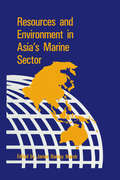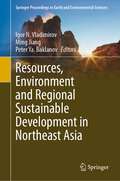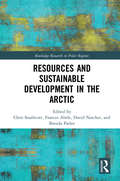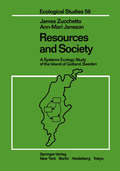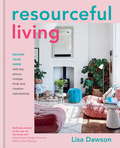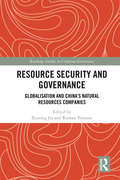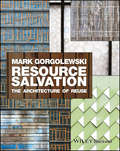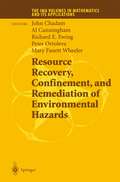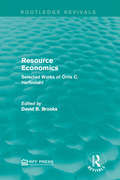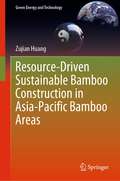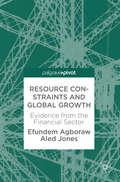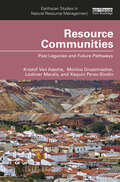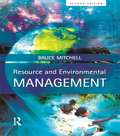- Table View
- List View
Resources & Environment in Asia's Marine Sector
by James B. MarshThis volume brings together a cross-section of marine experts who provide a comprehensive exploration of the major facets of Asia's marine sector. It considers both the marine mineral and fish stocks in Asian waters. This extensive volume examines "official" statistics with an objective eye and provides an overview of fish stock with much focus on the access and management of tuna. It considers global economic issues concerning fishing rights, looks at joint ventures between nations, and considers law enforcement efforts. The volume devotes a section to sea lanes and another to off shore mineral deposits. It also considers current and growing problems and possible solutions regarding pollution.
Resources, Environment and Regional Sustainable Development in Northeast Asia (Springer Proceedings in Earth and Environmental Sciences)
by Igor N. Vladimirov Ming Jiang Peter Ya. BaklanovThis book highlights the environmental issues, an assessment of environmental risks within the borders of Northeast Asia and neighboring territories. This book pays special attention to the transboundary factor as the main factor in international and interregional cooperation. This book develops methods of complex, thematic, interpretative mapping, geoinformation modeling, processing of remote sensing data for geographical and environmental studies, models for the analysis of spatial and temporal geographic data, and their long series. The book is planned to widely cover economic, physical–geographical and environmental studies, including the analysis of natural resources from the state of the natural environment and resource potential to its change under the influence of various factors.
Resources and Sustainable Development in the Arctic (Routledge Research in Polar Regions)
by Chris Southcott Frances Abele David Natcher Brenda ParleeOver the past thirty years we have witnessed a demand for resources such as minerals, oil, and gas, which is only set to increase. This book examines the relationship between Arctic communities and extractive resource development. With insights from leading thinkers in the field, the book examines this relationship to better understand what, if anything, can be done in order for the development of non-renewable resources to be of benefit to the long-term sustainability of these communities. The contributions synthesize circumpolar research on the topic of resource extraction in the Arctic, and highlight areas that need further investigation, such as the ability of northern communities to properly use current regulatory processes, fiscal arrangements, and benefit agreements to ensure the long-term sustainability of their culture communities and to avoid a new path dependency This book provides an insightful summary of issues surrounding resource extraction in the Arctic, and will be essential reading for anyone interested in environmental impact assessments, globalization and Indigenous communities, and the future of the Arctic region.
Resources and Sustainable Development in the Arctic (Routledge Research in Polar Regions)
by Chris Southcott Frances Abele David Natcher Brenda ParleeOver the past thirty years we have witnessed a demand for resources such as minerals, oil, and gas, which is only set to increase. This book examines the relationship between Arctic communities and extractive resource development. With insights from leading thinkers in the field, the book examines this relationship to better understand what, if anything, can be done in order for the development of non-renewable resources to be of benefit to the long-term sustainability of these communities. The contributions synthesize circumpolar research on the topic of resource extraction in the Arctic, and highlight areas that need further investigation, such as the ability of northern communities to properly use current regulatory processes, fiscal arrangements, and benefit agreements to ensure the long-term sustainability of their culture communities and to avoid a new path dependency This book provides an insightful summary of issues surrounding resource extraction in the Arctic, and will be essential reading for anyone interested in environmental impact assessments, globalization and Indigenous communities, and the future of the Arctic region.
Resources and Society: A Systems Ecology Study of the Island of Gotland, Sweden (Ecological Studies #56)
by James Zucchetto Ann-Mari JanssonAlthough this book is about a specific area of the world (i.e., Gotland, Sweden), the interdisciplinary nature of the study, with regard to resources, environment, and society, makes it of interest to a number of fields. We have tried to make this book readable for a wide variety of interested parties including systems ecologists, environmental scientists, resource economists, geographers, regional planners, and regional scientists, as well as those interested in Nordic conditions. Since this project was part of UNESCO's Man and the Biosphere (MAB) pro gram, this book should be of general interest to the international community. This book is certainly not a textbook, but we see it as being useful for courses in regional analysis with plenty of examples for illustrating analysis and models related to energy, environment, and economics, or to the general field of systems ecology. An instructor could, of course, supplement the material on systems and models with other sources. We hope this small book will serve as a helpful example of the analysis of the complex interdisciplinary problems associated with resources and society. In Chapter 1, we present a brief introduction to the Gotland study as well as to some of the concepts and theories that have guided our investigations.
Resourceful Living: Revamp Your Home With Key Pieces, Vintage Finds And Creative Repurposing
by Lisa DawsonIt's often thought that restyling your space comes with a hefty price tag and unavoidable waste. But in Resourceful Living, award-winning interiors blogger Lisa Dawson shows how, with a little creativity, you can revamp your home with existing pieces, vintage finds and key purchases. The clever ideas in this beautiful book cover:- The most important ways we use our homes, from eating to sleeping, living and working.- The Basics of steering clear of interiors 'fast fashion', multi-purposing furniture and making the most of what you have.- Styling Your Home with simple solutions for re-imagining each room, from gallery walls to home bars, repainted storage to retro accessories.Including her top ten key vintage buys and tips for in-store and online thrifting, Lisa's inspiring advice shares the fun of creative sourcing as a more sustainable way to keep your home feeling fresh.'Resourceful Living feels like reading a recipe book, not only because of the delicious interiors images, but because of the simple ingredients and easy methods that are shared to achieve beautiful living spaces for yourself.' Melanie Sykes'I've been a long-time fan and follower of Lisa's interiors tips. This book really is super practical as well as beautiful - perfect for anyone looking to be more interiors savvy.' Rachel Khoo
Resource Security and Governance: Globalisation and China’s Natural Resources Companies (Routledge Studies in Corporate Governance)
by Xinting Jia Roman TomasicChina’s phenomenal economic growth in the past 30 years has witnessed the rise of its global natural resources companies. At the same time, the emerging of a middle class in China and their desire to improve living standards including better dwelling conditions, better health and nutrition, has driven strong demand in mineral resources, energy and quality food. The so called ‘socialist market economy’ in China has seen this growing demand being met partially by companies with ‘national significance’. In the resources sector, these companies are represented by companies listed in stock exchanges in China as well as globally such as in New York and London; at the same time, most of these companies are also controlled by the Chinese government. China’s resources companies have expanded overseas in search of new acquisition targets whilst seeking to extend their global reach with a focus on resource rich countries. The expansion of these companies internationally, and the unique ownership structure of these companies, has posed challenges for regulators, trading partners of these companies, investors and other interested parties seeking to understand how these companies are governed and the implications of government ownership for resource security globally. Resource Security and Governance: The Globalisation of China’s Natural Resources Companies contains case studies of the global expansion efforts of Chinese global natural resources companies; it reviews the governance structures of these companies and analyses how these have affected the inter-relationship between these companies and their trading partners, governments, regulators in targeted countries and investors globally. In addition, this book examines how the unique structure of these companies may affect resource security globally and touches on other related matters such as climate change, and air and water security in China.
Resource Security and Governance: Globalisation and China’s Natural Resources Companies (Routledge Studies in Corporate Governance)
by Xinting Jia Roman TomasicChina’s phenomenal economic growth in the past 30 years has witnessed the rise of its global natural resources companies. At the same time, the emerging of a middle class in China and their desire to improve living standards including better dwelling conditions, better health and nutrition, has driven strong demand in mineral resources, energy and quality food. The so called ‘socialist market economy’ in China has seen this growing demand being met partially by companies with ‘national significance’. In the resources sector, these companies are represented by companies listed in stock exchanges in China as well as globally such as in New York and London; at the same time, most of these companies are also controlled by the Chinese government. China’s resources companies have expanded overseas in search of new acquisition targets whilst seeking to extend their global reach with a focus on resource rich countries. The expansion of these companies internationally, and the unique ownership structure of these companies, has posed challenges for regulators, trading partners of these companies, investors and other interested parties seeking to understand how these companies are governed and the implications of government ownership for resource security globally. Resource Security and Governance: The Globalisation of China’s Natural Resources Companies contains case studies of the global expansion efforts of Chinese global natural resources companies; it reviews the governance structures of these companies and analyses how these have affected the inter-relationship between these companies and their trading partners, governments, regulators in targeted countries and investors globally. In addition, this book examines how the unique structure of these companies may affect resource security globally and touches on other related matters such as climate change, and air and water security in China.
Resource Salvation: The Architecture of Reuse
by Mark GorgolewskiA valuable source of information, insight, and fresh ideas about a crucial aspect of the growing sustainable design movement Mounting resource shortages worldwide coupled with skyrocketing extraction costs for new materials have made the prospect of materials reuse and recycling an issue of paramount importance. A fundamental goal of the sustainable design movement is to derive utmost use from construction materials and components, including energy, water, materials, building components, whole structures, and even entire infrastructures. Written by an expert with many years of experience in both industry and academe, this book explores a wide range of sustainable design strategies which designers around the globe are using to create efficient and aesthetically pleasing buildings from waste streams and discarded items. Emphasizing performance issues, design considerations and process constraints, it describes numerous fully realized projects, and explores theoretical applications still on the drawing board. There is a growing awareness worldwide of the need for cyclical systems of materials reuse. Pioneering efforts at “closed-loop” design date as far back as 1960s, but only recently have architects and designers begun to focus on the opportunities which discarded materials can provide for creating high performance structures. A source of insight and fresh ideas for architects, engineers, and designers, Resource Salvation: Reviews the theory and practice of building material and waste reuse and describes best practices in that area worldwide Describes projects that use closed-loop thinking to influence and inspire the design of components, interiors, whole buildings, or urban landscapes Illustrates how using discarded materials and focusing on closed loops can lead to new concepts in architecture, building science, and urban design Demonstrates how designers have developed aesthetically compelling solutions to the demands of rigorous performance standards Resource Salvation is a source of information and inspiration for architects, civil engineers, green building professionals, building materials suppliers, landscape designers, urban designers, and government policymakers. It is certain to become required reading in university courses in sustainable architecture, as well as materials engineering and environmental engineering curricula with a sustainable design component.
Resource Salvation: The Architecture of Reuse
by Mark GorgolewskiA valuable source of information, insight, and fresh ideas about a crucial aspect of the growing sustainable design movement Mounting resource shortages worldwide coupled with skyrocketing extraction costs for new materials have made the prospect of materials reuse and recycling an issue of paramount importance. A fundamental goal of the sustainable design movement is to derive utmost use from construction materials and components, including energy, water, materials, building components, whole structures, and even entire infrastructures. Written by an expert with many years of experience in both industry and academe, this book explores a wide range of sustainable design strategies which designers around the globe are using to create efficient and aesthetically pleasing buildings from waste streams and discarded items. Emphasizing performance issues, design considerations and process constraints, it describes numerous fully realized projects, and explores theoretical applications still on the drawing board. There is a growing awareness worldwide of the need for cyclical systems of materials reuse. Pioneering efforts at “closed-loop” design date as far back as 1960s, but only recently have architects and designers begun to focus on the opportunities which discarded materials can provide for creating high performance structures. A source of insight and fresh ideas for architects, engineers, and designers, Resource Salvation: Reviews the theory and practice of building material and waste reuse and describes best practices in that area worldwide Describes projects that use closed-loop thinking to influence and inspire the design of components, interiors, whole buildings, or urban landscapes Illustrates how using discarded materials and focusing on closed loops can lead to new concepts in architecture, building science, and urban design Demonstrates how designers have developed aesthetically compelling solutions to the demands of rigorous performance standards Resource Salvation is a source of information and inspiration for architects, civil engineers, green building professionals, building materials suppliers, landscape designers, urban designers, and government policymakers. It is certain to become required reading in university courses in sustainable architecture, as well as materials engineering and environmental engineering curricula with a sustainable design component.
Resource Recovery, Confinement, and Remediation of Environmental Hazards (The IMA Volumes in Mathematics and its Applications #131)
This IMA Volume in Mathematics and its Applications RESOURCE RECOVERY, CONFINEMENT, AND REMEDIATION OF ENVIRONMENTAL HAZARDS contains papers presented at two successful one-week workshops: Confine ment and Remediation of Environmental Hazards held on January 15-19, 2000 and Resource Recovery, February 9-13, 2000. Both workshops were integral parts of the IMA annual program on Mathematics in Reactive Flow and Transport Phenomena, 1999-2000. We would like to thank John Chadam (University of Pittsburgh), Al Cunningham (Montana State Uni versity), Richard E. Ewing (Texas A&M University), Peter Ortoleva (In diana University), and Mary Fanett Wheeler (TICAM, The University of Texas at Austin) for their excellent work as organizers of the meetings and for editing the proceedings. We take this opportunity to thank the National Science Foundation for their support of the IMA. Series Editors Douglas N. Arnold, Director of the IMA Fadil Santosa, Deputy Director of the IMA v PREFACE Advances in resource recovery, and confinement/remediation of envi ronmental hazards requires a coordinated, interdisciplinary effort involving mathematicians, scientists and engineers. The intent of this collection of papers is to summarize recent theoretical, computational, and experimen tal advances in the theory of phenomena in porous media, with the intent to identify similarities and differences concerning applications related to both resource recovery and confinement and remediation of environmental hazards.
Resource Peripheries in the Global Economy: Networks, Scales, and Places of Extraction (Economic Geography)
by Felipe Irarrázaval Martín Arias-LoyolaThis book discusses the conditions that underpin configuration of specific places as resource peripheries and the consequences that such a socio-spatial formation involves for those places. The book thereby provides an interdisciplinary approach underpinned by economic geography, political ecology, resource geography, development studies and political geography. It also discusses the different technological, political and economic changes that make the ongoing production of resource peripheries a distinctive socio-spatial formation under the global economy. Through a global and interdisciplinary perspective that uncovers ongoing political processes, socio-economic changes and socio-ecological dynamics at resource peripheries, this book argues that it is critical to take a more profound appraisal about the socio-spatial processes behind the contemporary way in which capitalism is appropriating and transforming nature.
Resource Management, Sustainable Development and Governance: Indian and International Perspectives (Sustainable Development Goals Series)
by Rajiv R. Thakur Baleshwar Thakur Srikumar Chattopadhyay Rajesh K. AbhayThis book examines the relationship between natural resource management, sustainable development, and governance with case studies from India and other places covering disaster risk reduction, conflict resolution, capacity building, climate change adaptation and resilience, citizen engagement and ecological conservation. Though the studies focus mostly on cases in India, the volume discusses how governance can be employed to help develop and implement sustainable practices globally through the lens of the United Nations Sustainable Development Goals (SDGs) framework. Readers will learn how to integrate concepts of resource management, sustainable development, and governance to improve human resilience to global environmental change, and to assess the proper development approaches to assist economically stressed and resource-deprived individuals. The book will be of use to graduate students and academics, policy makers, planners, and nonprofits.
Resource Management in Rice Systems: Papers presented at the International Workshop on Natural Resource Management in Rice Systems: Technology Adaption for Efficient Nutrient Use, Bogor, Indonesia, 2–5 December 1996 (Developments in Plant and Soil Sciences #81)
by V. Balasubramanian J. K. Ladha G. L. DenningRice is the major staple food in Asia, and food security means rice security for most Asians. By the year 2025, we need to produce about 60% more rice than we do today to meet the growing demand. Efficient use of inputs is vital to safely produce the additional food from limited resources with minimal impact on the environment. This book reviews emerging knowledge-intensive technologies and decision aids for improved nutrient management in rice, technology adoption constraints at the farm level, and innovative approaches for field evaluation and promotion of new technologies to farmers. It is highly useful to rice scientists and development workers, students of agronomy, soil science, and plant nutrition, and crop consultants and extension workers in rice all over the world.
Resource Management and Contested Territories in East Asia
by R. EmmersRalf Emmers discusses the significance of natural resources as a source of inter-state cooperation and competition in East Asia, assessing whether the joint exploration and development of resources can act as a means to reduce tensions in contested territories. Does the joint management of natural resources in the absence of a negotiated maritime delimitation constitute a feasible strategy to de-escalate maritime sovereignty disputes in East Asia? Can cooperative resource exploitation be separated from nationalist considerations and power politics calculations? Alternatively, should the prospect for joint exploration in disputed waters be expected to raise rather than defuse territorial conflicts, especially if abundant resources are eventually discovered? If this were true, should exploration schemes be postponed until sovereignty disputes have been resolved? Emmers addresses these questions by examining the overlapping sovereignty claims in the Sea of Japan and the East and South China Seas.
Resource Governance and Developmental States in the Global South: Critical International Political Economy Perspectives (International Political Economy Series)
by Jewellord Nem Singh France BourgouinThe political economy landscape has shifted as multinational corporations increase their investment efforts, changing the geographies of extraction. The contributors make the argument for the need of new theoretical perspectives anchored in critical political economy to address structural dynamics in the global industry.
Resource Economics: Selected Works of Orris C. Herfindahl (Routledge Revivals)
by David B. BrooksOnly a few economists have vigorously dealt with mineral economics. Among these few, Orris C. Herfindahl has probably probed the most deeply. This volume, originally published in 1974, presents Herfindahl’s most significant and enlightening contributions to the field of resource economics. This title will be of interest to students of environmental studies and economics, as well as to professional resource specialists.
Resource Economics: Selected Works of Orris C. Herfindahl (Routledge Revivals)
by David B. BrooksOnly a few economists have vigorously dealt with mineral economics. Among these few, Orris C. Herfindahl has probably probed the most deeply. This volume, originally published in 1974, presents Herfindahl’s most significant and enlightening contributions to the field of resource economics. This title will be of interest to students of environmental studies and economics, as well as to professional resource specialists.
Resource-Driven Sustainable Bamboo Construction in Asia-Pacific Bamboo Areas (Green Energy and Technology)
by Zujian HuangThis book presents the new approach of resource-driven bamboo construction (RDBC), developing a clear assessment framework and operational solution to improve the value of resources and the sustainability of bamboo constructions. The book discusses how to carry out research on basic parameters and life cycle assessment, as well demonstrating the approach in practice. This book develops a sustainability assessment model for bamboo construction in Asia-Pacific bamboo areas to measure the effects and success of RDBC. It solves issues related to environmental impact, energy consumption, land cost, indoor comfort, construction durability, and sustainable material application of the bamboo constructions. It utilizes digital tools to perform statistical analysis on large sample conditions, enabling the method to be better implemented, and presents case studies of RDBC method in action. The large amount of data collected, method guidance, and demonstrations provide a comprehensive reference for those wishing to apply bamboo in the building industry. This book is particularly relevant to scientists, professionals, architects, civil engineers, and students who are interested in bamboo material and its application in building industry. It provides readers with a new perspective of the high-value utilization of bamboo forest resources and methods to achieve sustainable bamboo construction.
Resource Constraints and Global Growth: Evidence from the Financial Sector
by Efundem Agboraw Aled JonesWith substantial risks arising from resource constraints on global growth, serious questions are being posed about how a scarcity of finite resources may impact global social and political fragility. The research which forms the core of this book focuses on how this scarcity will impact the financial sector, especially through insurance, pension and banking activities. The UK finance sector, which is considered to be amongst the most globalised, is placed under the microscope, and its approaches to food and oil are particularly noteworthy. Interviews with senior financial experts are analysed alongside more traditional quantitative economic analysis to explore potential future impacts, the scope of natural resource constraints and their impact on the economy.
Resource Constraints and Global Growth: Evidence from the Financial Sector
by Efundem Agboraw Aled JonesWith substantial risks arising from resource constraints on global growth, serious questions are being posed about how a scarcity of finite resources may impact global social and political fragility. The research which forms the core of this book focuses on how this scarcity will impact the financial sector, especially through insurance, pension and banking activities. The UK finance sector, which is considered to be amongst the most globalised, is placed under the microscope, and its approaches to food and oil are particularly noteworthy. Interviews with senior financial experts are analysed alongside more traditional quantitative economic analysis to explore potential future impacts, the scope of natural resource constraints and their impact on the economy.
Resource Communities: Past Legacies and Future Pathways (Earthscan Studies in Natural Resource Management)
by Kristof Van Assche Monica Gruezmacher Lochner Marais Xaquin Perez-SindinThis book provides an innovative approach to understanding the governance of resource communities, by showcasing how the past and present informs the future. Resource communities have complicated relationships with the past, and this makes their relationship with the future, and the future itself, also complicated. The book digs deeply into the myriad legacies left by a history of resource extraction in a community and makes use of interdisciplinary and transdisciplinary perspectives to understand the complex issues being faced by a range of different communities that are reliant on different types of resources across the world. From coal and gold mining, to fishing towns and logging communities, the book explores the legacies of boom and bust economies, social memory, trauma and identity, the interactions between power and knowledge and the implications for adaptive governance. Balancing conceptual and theoretical understandings with empirical and practical knowledge of resource communities, natural resource use and social-ecological relationships, the book argues that solutions for individual communities need to be embraced in the community and not just in the perspectives of visiting experts. Linking the past, present and futures of resource communities in a new way, the book concludes by providing practical recommendations for breaking open dependencies on the past, including deepening awareness of the social, economic and environmental contexts, establishing strong governance and developing community strategies, plans and policies for the future. This book will be of great interest to students and scholars of natural resource governance and management, extractive industries, environmental policy, community planning and development, environmental geography and sustainable development, as well as policymakers involved in supporting community development in natural resource-dependent communities across the world.
Resource Communities: Past Legacies and Future Pathways (Earthscan Studies in Natural Resource Management)
by Kristof Van Assche Monica Gruezmacher Lochner Marais Xaquin Perez-SindinThis book provides an innovative approach to understanding the governance of resource communities, by showcasing how the past and present informs the future. Resource communities have complicated relationships with the past, and this makes their relationship with the future, and the future itself, also complicated. The book digs deeply into the myriad legacies left by a history of resource extraction in a community and makes use of interdisciplinary and transdisciplinary perspectives to understand the complex issues being faced by a range of different communities that are reliant on different types of resources across the world. From coal and gold mining, to fishing towns and logging communities, the book explores the legacies of boom and bust economies, social memory, trauma and identity, the interactions between power and knowledge and the implications for adaptive governance. Balancing conceptual and theoretical understandings with empirical and practical knowledge of resource communities, natural resource use and social-ecological relationships, the book argues that solutions for individual communities need to be embraced in the community and not just in the perspectives of visiting experts. Linking the past, present and futures of resource communities in a new way, the book concludes by providing practical recommendations for breaking open dependencies on the past, including deepening awareness of the social, economic and environmental contexts, establishing strong governance and developing community strategies, plans and policies for the future. This book will be of great interest to students and scholars of natural resource governance and management, extractive industries, environmental policy, community planning and development, environmental geography and sustainable development, as well as policymakers involved in supporting community development in natural resource-dependent communities across the world.
Resource and Environmental Management
by Bruce MitchellThis book does an exceptional job in giving an understanding of change, complexity, uncertainty and conflict as well as their linkages, including awareness of strategies, methods and techniques to handle them relative to resource and environmental management. The text enhances the reader's capacity to conduct practice and conduct research in resource and environmental management.
Resource and Environmental Management
by Bruce MitchellThis book does an exceptional job in giving an understanding of change, complexity, uncertainty and conflict as well as their linkages, including awareness of strategies, methods and techniques to handle them relative to resource and environmental management. The text enhances the reader's capacity to conduct practice and conduct research in resource and environmental management.
